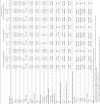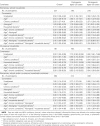Seasonal influenza vaccine and increased risk of pandemic A/H1N1‐related illness: first detection of the association in British Columbia, Canada
- PMID: 20887210
- PMCID: PMC7107856
- DOI: 10.1086/656586
Seasonal influenza vaccine and increased risk of pandemic A/H1N1‐related illness: first detection of the association in British Columbia, Canada
Abstract
Background: In April 2009, an elementary school outbreak of pandemic H1N1 (pH1N1) influenza was reported in a community in northern British Columbia, Canada--an area that includes both non-Aboriginal and Aboriginal residents living on or off a reserve. During the outbreak investigation, we explored the relationship between prior receipt of trivalent inactivated influenza vaccine (TIV) and pH1N1-related illness.
Methods: A telephone survey was conducted from 15 May through 5 June 2009 among households of children attending any school in the affected community. Members of participating households where influenza-like illness (ILI) was described were then invited to submit blood samples for confirmation of pH1N1 infection by hemagglutination inhibition and microneutralization assays. Circulation of pH1N1 was concentrated among households of the elementary school and elsewhere-reserve to which analyses of TIV effect were thus restricted. Odds ratios (ORs) for the TIV effect on ILI were computed through logistic regression, with adjustment for age, comorbidity, household density, and Aboriginal status. The influence of within-household clustering was assessed through generalized-linear-mixed models.
Results: Of 408 participants, 92 (23%) met ILI criteria: 29 (32%) of 92 persons with ILI, compared with 61 (19%) 316 persons without ILI, had received the 2008-2009 formulation of TIV. Fully adjusted ORs for 2008-2009 TIV effect on ILI were 2.45 (95% confidence interval, 1.34-4.48) by logistic regression and 2.68 [95% confidence interval, 1.37-5.25) by generalized-linear-mixed model.
Conclusions: An outbreak investigation in British Columbia during the late spring of 2009 provided the first indication of an unexpected association between receipt of TIV and pH1N1 illness. This led to 5 additional studies through the summer 2009 in Canada, each of which corroborated these initial findings.
Figures




Similar articles
-
Transmission dynamics and risk factors for pandemic H1N1-related illness: outbreak investigation in a rural community of British Columbia, Canada.Influenza Other Respir Viruses. 2012 May;6(3):e54-62. doi: 10.1111/j.1750-2659.2012.00344.x. Epub 2012 Mar 2. Influenza Other Respir Viruses. 2012. PMID: 22385647 Free PMC article.
-
Association between the 2008-09 seasonal influenza vaccine and pandemic H1N1 illness during Spring-Summer 2009: four observational studies from Canada.PLoS Med. 2010 Apr 6;7(4):e1000258. doi: 10.1371/journal.pmed.1000258. PLoS Med. 2010. PMID: 20386731 Free PMC article.
-
Protective efficacy of seasonal influenza vaccination against seasonal and pandemic influenza virus infection during 2009 in Hong Kong.Clin Infect Dis. 2010 Dec 15;51(12):1370-9. doi: 10.1086/657311. Epub 2010 Nov 10. Clin Infect Dis. 2010. PMID: 21067351 Clinical Trial.
-
Serologically confirmed household transmission of 2009 pandemic influenza A (H1N1) virus during the first pandemic wave--New York City, April-May 2009.Clin Infect Dis. 2011 Sep;53(5):455-62. doi: 10.1093/cid/cir437. Clin Infect Dis. 2011. PMID: 21844028
-
Influenza and HIV: lessons from the 2009 H1N1 influenza pandemic.Curr HIV/AIDS Rep. 2011 Sep;8(3):181-91. doi: 10.1007/s11904-011-0086-4. Curr HIV/AIDS Rep. 2011. PMID: 21710214 Review.
Cited by
-
Immunogenicity and cross-reactivity of 2009-2010 inactivated seasonal influenza vaccine in US adults and elderly.PLoS One. 2011 Jan 31;6(1):e16650. doi: 10.1371/journal.pone.0016650. PLoS One. 2011. PMID: 21304946 Free PMC article.
-
Immunity against heterosubtypic influenza virus induced by adenovirus and MVA expressing nucleoprotein and matrix protein-1.Sci Rep. 2013;3:1443. doi: 10.1038/srep01443. Sci Rep. 2013. PMID: 23485942 Free PMC article.
-
Options and obstacles for designing a universal influenza vaccine.Viruses. 2014 Aug 18;6(8):3159-80. doi: 10.3390/v6083159. Viruses. 2014. PMID: 25196381 Free PMC article. Review.
-
Seasonal influenza and vaccine herd effect.Clin Exp Vaccine Res. 2014 Jul;3(2):128-32. doi: 10.7774/cevr.2014.3.2.128. Epub 2014 Jun 20. Clin Exp Vaccine Res. 2014. PMID: 25003085 Free PMC article. Review.
-
Towards universal influenza vaccines?Philos Trans R Soc Lond B Biol Sci. 2011 Oct 12;366(1579):2766-73. doi: 10.1098/rstb.2011.0102. Philos Trans R Soc Lond B Biol Sci. 2011. PMID: 21893539 Free PMC article.
References
-
- BC Stats. Victoria, British Colombia, Canada: BC Stats; 2008. [Accessed 30 March 2010]. Socio-economic profiles local health areas: maps. http://www.bcstats.gov.bc.ca/data/sep/lha/lhamap.asp.
-
- BC Stats. Victoria, British Colombia, Canada: BC Stats; 2008. [Accessed 6 April 2010.]. British Columbia Indian reserve census figures: 2006 census total population results. http://www.bcstats.gov.bc.ca/data/cen06/ir2006.asp.
-
- Novel Swine-Origin Influenza A (H1N1) Virus Investigation Team Emergence of a novel swine-origin influenza A (H1N1) virus in humans. N Engl J Med. 2009;360:2605–2615. - PubMed
-
- National Advisory Committee on Immunization Statement on seasonal trivalent inactivated influenza vaccine (TIV) for the 2009–2010 season. Can Commun Dis Rep. 2009;35(ACS-6):1–41. http://www.phac-aspc.gc.ca/publicat/ccdr-rmtc/09pdf/acs-dcc-06.pdf. - PMC - PubMed
-
- Committee for Proprietary Medicinal Products . London, UK: European Agency for the Evaluation of Medicinal Products; 1997. [Accessed 30 March 2010]. Note for guidance on harmonization of requirements for influenza vaccines. http://www.emea.europa.eu/pdfs/human/bwp/021496en.pdf.
Publication types
MeSH terms
Substances
LinkOut - more resources
Full Text Sources
Medical
Miscellaneous

